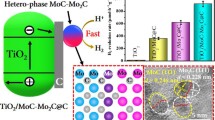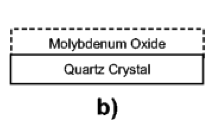Abstract
In the work, the temperature-programmed reduction reaction between NH3 and h-MoO3 under different conditions was investigated in order to prepare Mo2N. Various technologies such as XRD, FESEM, and thermodynamic calculation were adopted to analyze the experimental data. The results demonstrated that the formation of Mo2N primarily involved two stages: the reduction of h-MoO3 to MoO2 and the nitridation of MoO2 to Mo2N. In the reduction stage, both NH3 and H2 acted as the reducing agents; while only NH3 acted as the nitridizing agent during the nitridation stage. The results also showed that when pure h-MoO3 was used, the resulting Mo2N exhibited an irregular granular morphology, differed significantly from the hexagonal structure of raw material. However, when Fe-doped h-MoO3 was used, the resulting Mo2N maintained the overall hexagonal shape with a loose and porous surface structure, which provided a new way for preparing hexagonal-shaped Mo2N. The possible mechanism of morphological evolution was also illustrated.












Similar content being viewed by others
References
X. Xiao, H.M. Yu, H.Y. Jin, M.H. Wu, Y.S. Fang, J.Y. Sun, Z. Hu, T. Li, J. Wu, L. Huang, Y. Gogotsi, and J. Zhou: ACS Nano, 2017, vol. 11, pp. 2180–86.
M. Naguib and Y. Gogotsi: Acc. Chem. Res., 2015, vol. 48, pp. 128–35.
B. Anasori, Y. Xie, M. Beidaghi, J. Lu, B.C. Hosler, and L. Hultman: ACS Nano, 2015, vol. 9, pp. 9507–16.
L. Ma, L.R.L. Ting, V. Molinari, C. Giordano, and B.S. Yeo: J. Mater. Chem. A, 2015, vol. 3, pp. 8361–68.
Y.J. Song and Z.Y. Yuan: Electrochim. Acta, 2017, vol. 246, pp. 536–43.
L.X. Wang, Z.H. Zhang, L. Li, L.S. Zhang, H. Fang, and X.F. Li: CIESC J., 2020, vol. 71, pp. 5854–62.
M. Kožejová, V. Latyshev, V. Kavecansky, H. You, S. Vorobiov, A. Kovalčíková, and V. Komanický: Electrochim. Acta, 2019, vol. 315, pp. 9–16.
S.P. Zhang, Y. Yao, X.J. Jiao, M.Z. Ma, H.J. Huang, X.F. Zhou, L.F. Wang, J.T. Bai, and Y. Yu: Adv. Mater., 2021, vol. 33, p. 2103848.
F. Ma, K. Srinivas, X.J. Zhang, Z.H. Zhang, Y. Wu, D.W. Liu, W.L. Zhang, Q. Wu, and Y.F. Chen: Adv. Funct. Mater., 2022, vol. 32, p. 2206113.
K. Wu, M.J. Zhu, Y. Yang, R.T. Tian, and F.X. Li: Chem. Bioeng., 2022, vol. 39, pp. 1–6.
Y.J. Jiang, M.Y. Zhao, P. Zhao, M.H. Lu, J. Zhu, M.S. Li, and Y.H. Shan: J. Chem. Eng. Chin. Univ., 2021, vol. 35, pp. 476–82.
X.R. Zhang, H. Peng, S.Y. Dong, L.M. Tang, Y. Zhang, and Y.G. Wu: J. Vac. Sci. Technol., 2022, vol. 42, pp. 185–92.
X.P. Liu, K.S. Wang, X.M. He, and P. Gu: Ordnance Mater. Sci. Eng., 2020, vol. 43, pp. 81–85.
H.B. Ju, L.H. Yu, and J.H. Xu: Chin. J. Vac. Sci. Technol., 2014, vol. 34, pp. 469–72.
C. Wang, Y.H. Wang, and X. Wu: Mater. Lett., 2021, vol. 287, p. 129292.1–91.
S.W. Wang, H.G. Gao, J.W. Xie, and L.X. Wang: Battery Bimonthly, 2020, vol. 50, pp. 450–53.
J.J. Yu, L. Wang, and Z.L. Xue: Ceram. Int., 2023, vol. 49, pp. 33135–46.
D. Abdoulaye, J.B. Siegel, and A. Olabode: Nano Energy, 2018, vol. 51, pp. 122–27.
S.L. Liu, J. Huang, and J. Liu: Mater. Lett., 2016, vol. 172, pp. 56–59.
K. Dewangan, S.S. Patil, D.S. Joag, M.A. More, and N. Gajbhiye: J. Phys. Chem. C, 2010, vol. 114, pp. 14710–15.
L. Wang, G.H. Zhang, and K.C. Chou: J. Solid State Chem., 2017, vol. 254, pp. 96–102.
L. Wang, H.X. Li, and Z.L. Xue: Trans. Nonferrous Met. Soc. China, 2023, vol. 33, pp. 2155–67.
H.X. Li, L. Wang, and F.J. Du: CrystEngComm, 2023, vol. 25, pp. 4089–99.
Z.Q. Liu, H.X. Li, and L. Wang: China Molybdenum Industry, 2023, vol. 47, pp. 45–48.
G.D. Sun, G.H. Zhang, and K.C. Chou: J. Am. Ceram. Soc., 2018, vol. 101, pp. 2796–2808.
C.W. Bale, E. Bélisle, and P. Chartrand: Calphad, 2009, vol. 33, p. 295.
L. Wang, G.H. Zhang, and K.C. Chou: J. Am. Ceram. Soc., 2017, vol. 100, pp. 1368–76.
L. Wang, G.H. Zhang, and Z.L. Xue: Chem. Lett., 2019, vol. 48, pp. 475–78.
X. Song, W. Yi, J. Li, Q. Kong, H. Bai, and G. Xi: Nano Lett., 2021, vol. 21, pp. 4410–14.
A. Chithambararaj, N. Sanjini, S. Velmathi, and A.C. Bose: Phys. Chem. Chem. Phys., 2013, vol. 15, pp. 14761–69.
A. Chithambararaj, Y.N. Rajeswari, and A.C. Bose: Cryst. Growth Des., 2016, vol. 16, pp. 1984–95.
L. Wang and G.H. Zhang: J. Phys. Chem. C, 2016, vol. 120, pp. 4097–4103.
M.C. Li, L. Wang, and Z.L. Xue: Int. J. Refract. Hard. Met., 2023, vol. 116, p. 106358.
H. Liang, X.B. Zha, and K.T. Gui: Proc. CSEE., 2014, vol. 34, pp. 5734–40.
Acknowledgments
The authors gratefully acknowledge the financial support for this work from the National Natural Science Foundation of China (52104310). The authors would also like to thank the Analytical & Testing Center of Wuhan University of Science and Technology for the help on the FESEM micrographs analysis.
Conflict of interest
On behalf of all authors, the corresponding author states that there is no conflict of interest.
Author information
Authors and Affiliations
Corresponding author
Additional information
Publisher's Note
Springer Nature remains neutral with regard to jurisdictional claims in published maps and institutional affiliations.
Rights and permissions
Springer Nature or its licensor (e.g. a society or other partner) holds exclusive rights to this article under a publishing agreement with the author(s) or other rightsholder(s); author self-archiving of the accepted manuscript version of this article is solely governed by the terms of such publishing agreement and applicable law.
About this article
Cite this article
Li, HX., Wang, L. & Xue, ZL. A Novel Way for Preparing Hexagonal-Shaped Mo2N by NH3 Reduction of Fe-Doped h-MoO3. Metall Mater Trans B (2024). https://doi.org/10.1007/s11663-024-03099-x
Received:
Accepted:
Published:
DOI: https://doi.org/10.1007/s11663-024-03099-x




